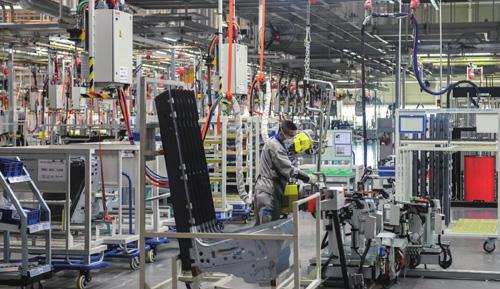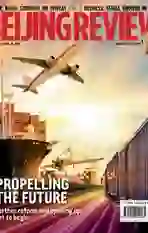GIVE AND GROW
2018-05-09ByMeiXinyu
By Mei Xinyu
After 40 years of reform and opening up, China is playing the role of stabilizer and powerhouse of the global economy rather than a stabilizer of the East Asian economy as it was in the 1980s. The countrys average annual contribu- tion to world economic growth had grown from 14.2 percent during the period of the countrys 11th Five-Year Plan (2006-10) for social and economic development to 30.5 percent during the 12th Five-Year Plan (2011-15) period. In 2016, China contributed 41.3 percent to world economic growth, while the United States and Japan contributed 16.3 percent and 1.4 percent, respectively.
In a broader sense, China is steadily resuming its leading status in the world economy, and in the foreseeable future the Chinese economy will exhibit six defi ning characteristics: seeing that its share of the global economy and trade returns to historical norms; completing the transformation from an agricultural society to a global manufacturing center for diversifi ed products and maintaining this status for a long time; remaining the worlds largest exporter and one of its top importers; shifting from being an exporter of goods to a stable source of commercial capital; exerting a growing influence in the making of international economic rules; and holding greater pricing power in the global market.
All of these changes are evidence of Chinas role as the standard-bearer of global free trade. During recent trade disputes with other countries, the United States, despite having led the integration of the world economy for decades, has begun to step back from globalization, while in China, as is clear from the outcomes of the 19th National Congress of the Communist Party of China and the recent sessions of the National Peoples Congress and the National Committee of the Chinese Peoples Political Consultative Conference, the top leadership is seeking to open the country wider to the outside world, enacting measures to facilitate trade and ease market access restrictions.
On March 26, as the U.S. Government was launching a $50-billion-trade war against China, Chinese Minister of Commerce Zhong Shan and Indian Minister of Commerce and Industry Suresh Prabhu co-chaired the 11th Session of China-India Joint Group on Economic Relations, Trade, Science and Technology in New Delhi, the theme of which was to mutually expand market access premised on the fact that Chinas imports from India grew nearly 40 percent in 2017. China did so not for the sake of reputation, but because as the worlds largest exporter, largest manufacturing nation and second largest economy, it needs globalization. Moreover, who is there but China to carry the standard of free trade in the current world order?
Global leadership
At the opening ceremony of the Boao Forum for Asia Annual Conference 2018 on April 10, Chinese President Xi Jinping delivered a keynote speech in which he assured the world that the Chinese people would continue to increase openness and expand cooperation. He pledged efforts to break new ground in opening China further through links running eastward and westward, across land and over sea. According to Xi, the country will adopt policies to promote high-standard liberalization and facilitation of trade and investment, and explore the opening of free trade ports with Chinese characteristics. In pursuit of further opening, China will significantly broaden market access, create a more attractive investment environment, strengthen the protection of intellectual property rights, and take the initiative to expand imports.
As it assumes the mantle of free trade, Chinas economy is entering its third phase of development following the adoption of the reform and opening-up policy in the late 1970s. With the first stage geared toward “entering the international market on an equal basis” and the second “seeking development from the international market,” the third phase aims to “lead the globalized market.” This transition will not only bring Chinese commodities, services and opportunities to foreign businesses, but also heighten the prospect that China will further open its domestic market and that the countrys imports will accelerate their increase.
Why must China further open up the domestic market in this current phase of development? This is primarily due to Chinas rapid industrialization in the first two phases, during which most of its industries reached maturity. These industries no longer require protection, but instead need competition in order to maintain their vitality. In 1989 Chinas annual output of automobiles stood at only 583,500 units, while in 2017 the country produced 29.02 million vehicles, selling 28.88 million of them to surpass the United States, the worlds top automobile producer and supplier since the invention of cars, which sold 17.2 million automobiles. It is no longer necessary for China to maintain the same level of protection of the auto industry. Instead, such safeguards would likely produce inertia and limit the industrys desire for progress.
On April 17, China announced plans to scrap share-holding limits in the automobile, shipbuilding and airplane manufacturing sectors for foreign investors. The limits for special-purpose vehicles and new-energy vehicles will be removed this year, while those for commercial vehicles and passenger vehicles will be lifted in 2020 and 2022, respectively, said the National Development and Reform Commission.
This year will also see the scrapping of limits on shipbuilding processes including design, manufacture and repair, as well as on the production of airplanes including trunk and regional airliners, generalpurpose airplanes, helicopters, drones and aerostats, according to the commission.
The biggest driver of growth among Chinese imports since the 1990s has been energy and raw material products, but now the import of foreign manufactured goods will instead see the fastest rate of growth.
Positive outlook
The prospects of the global economy are bright for 2018, making it possible for the rest of the world to purchase more goods made in China. In 2017 both the Chinese economy and the global economy outdid predictions for their growth, while all the major economies of the world saw faster growth rates, laying solid foundations for this years outlook.
In 2017 the U.S. economy expanded 2.3 percent, with the fourth quarter in particular showing a tendency of faster growth with a rate of 2.5 percent. The eurozone achieved growth of 2.3 percent, higher than the rate of 1.8 percent in 2016, with the growth rates in the third and fourth quarters standing at 2.7 percent. Japan realized a growth rate of 1.7 percent for 2017, and in the third and fourth quarters these figures stood at 1.9 percent and 2 percent, respectively.
For the first two months of this year, the JPMorgan Global Manufacturing Purchasing Managers Index stood at 54.4 and 54.2, a reading above 50 indicating economic expansion. The World Economic Outlook report issued by the International Monetary Fund (IMF) also made an optimistic forecast for this years world economic growth in response to the positive signs around the globe.
According to the IMF report, the growth of advanced economies is expected to exceed 2 percent in 2018 and 2019, while the U.S. growth forecast has been raised from 2.3 percent to 2.7 percent in 2018 and 1.9 percent to 2.5 percent in 2019, with the effect of changes to U.S. tax policy on economic growth estimated to be positive through 2020. The forecast for the European Union and Japan is also optimistic. The report also predicts that emerging and developing Asian economies will grow at a rate of around 6.5 percent over 2018-19, approximately the same as 2017, while the region will continue to account for over half of total global growth.
These positive inferences are possible because China is more capable than almost any other country in the world at addressing potential risks on the path to economic stabilization and growth, such as the issue of debt and trade disputes provoked by the United States. In the past few years China has demonstrated a convincing ability to address economic risks. This year the country will once again display the same level of competence in dealing with a trade war incited by the United States.
